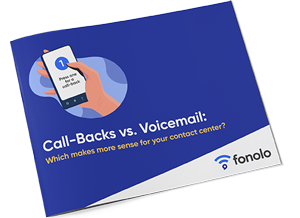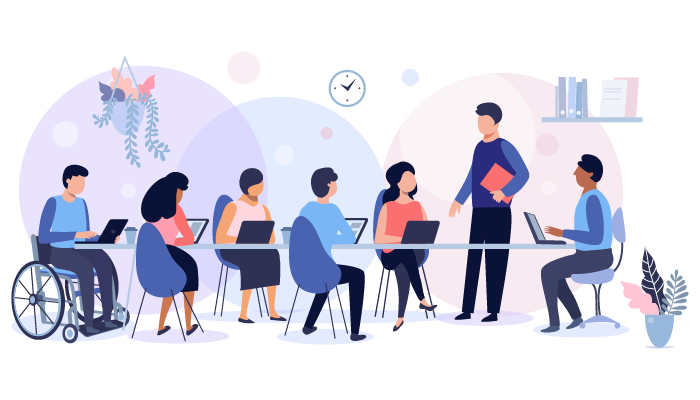Do you ever feel frustrated when you’re navigating an outdated website that’s not user-friendly? Who doesn’t? Today’s customer craves the swift and easy—and this rings 1000 times more true for call center customers. In other words? Your customer service should be accessible to everyone.
But contact center accessibility doesn’t just help people with disabilities—it helps every customer. And it helps your business, too. Contact center accessibility depends on two main factors: commitment and call center tech. Let’s explore how you can leverage both to take customer satisfaction to the next level.
What is Contact Center Accessibility?
Contact center accessibility makes every interaction, task, and follow-up easier for your customers and agents…more on agent accessibility later! Bottom line? Contact center accessibility makes it easier for your customers to access impeccable customer service. You can create an accessible call center through multiple channels. Before we get into the deets, let’s touch on the three types of accessibility to get you warmed up.
3 Types of Accessibility
Visual Accessibility: Blindness, color blindness, and color or light sensitivity are common visual impairments people might experience. Visual accessibility in a call center might look like this:
- Have screen readers available
- Offer a large IVR font
Motor Accessibility: Pain or restriction in physical muscles like your hands, fingers, or neck are motor issues that come with disabilities like spinal injuries, cerebral palsy, arthritis, and other conditions. Motor accessibility in a call center might look like this:
- Have standing desks available
- Offer head wands
- Install speech recognition software
Auditory Accessibility: Different stages of hearing loss and auditory processing disorders are common examples of auditory disabilities. Auditory accessibility in a call center might look like this:
- Offer Web Call-Backs (formerly Visual IVR)
- Have transcripts available
- Turn on captions
Why is Accessible Customer Service Important for Customer Satisfaction?
Contact center accessibility serves your call center, customers, and agents. Here’s how:
Tap Into a Larger Talent Pool
The US has over 61 million adults with a disability. At first glance, you might overlook a candidate who’s hard of hearing for a call center job. You should think again. Here’s why:
- Call center attrition is higher than in any other industry
- Training and tech can help your candidates excel
Contact center accessibility could enhance your recruitment process. A wider talent pool means quicker attrition recovery and inclusion. How does this tie to customer satisfaction? By widening your recruitment to include a new talent pool, you welcome new perspectives and expertise to your operation.
Communication giant Verizon describes how diverse teams are more representative of your wide customer base. Meaning? Agents with disabilities can better connect with customers with similar disabilities. For example, a hard-of-hearing customer might feel more comfortable video chatting with an agent who uses American Sign Language. Similarly, a neurodivergent agent might offer more empathy to a similar-minded customer. And more understanding and empathy among your agents improve customer experience and satisfaction.
Fonolo’s Voice Call-Backs make it easier for customers to access your product or services. The result: improved customer satisfaction, engaged agents, smoothed-out peak volumes and most importantly? #Contactcenteraccessibility. Click To TweetCustomer and Company Alignment
Customer satisfaction isn’t just about customer service: it’s also about shared values. If you’re an animal activist, you might not engage with a company that sells fur. Likewise, people with disabilities (or anyone who considers themselves an ally) might not feel aligned with businesses that don’t prioritize accessibility.
In 2021, 66% of Americans agreed that they prefer to support companies who share their values—significantly higher than the 50% of people who reported feeling that way in 2013.
Here’s the thing: you don’t have to place your accessibility priorities on billboards. Here are some quick ways to let your customers know you value accessibility:
- Inviting customers to request alternative formats for communication.
- Encouraging people with disabilities to apply for company positions.
- Providing accessibility training to your agents.
FACT:
75% of people with disabilities and their families have abandoned a business due to poor disability awareness.
Easier Access to Services
Accessible customer service brings your customers closer to your product or services. And easier access equals better customer experience, just ask Microsoft. All customers appreciate an easy interaction. A customer who is hard of hearing would enjoy the flexibility of Web Call-Backs offers through live chat. A customer who just doesn’t like speaking on the phone will appreciate it too.
Fonolo’s Voice Call-Backs also improve accessibility to services. Long wait times are frustrating for everyone, but they are yet another barrier for customers with disabilities.
Better Agent Engagement
If your call center already includes people with disabilities in the recruitment process, you’re on the right path. But you can continue the momentum and build stronger accessibility practices in the workplace.
Every call center leader constantly seeks ways to engage agents. In addition to popular tools like flexible work arrangements, recognition, and career development opportunities, improved accessibility helps, too. Remember, accessibility on the floor might seem like it only impacts your agents, but it has a positive trickle-down effect on customer satisfaction.
3 Ways to Improve Accessibility for Agents
- Update call center technology with accessibility features like screen readers.
- Offer alternative communication methods like live chat, email, and others through Web Call-Backs.
- Conduct regular accessibility training.

